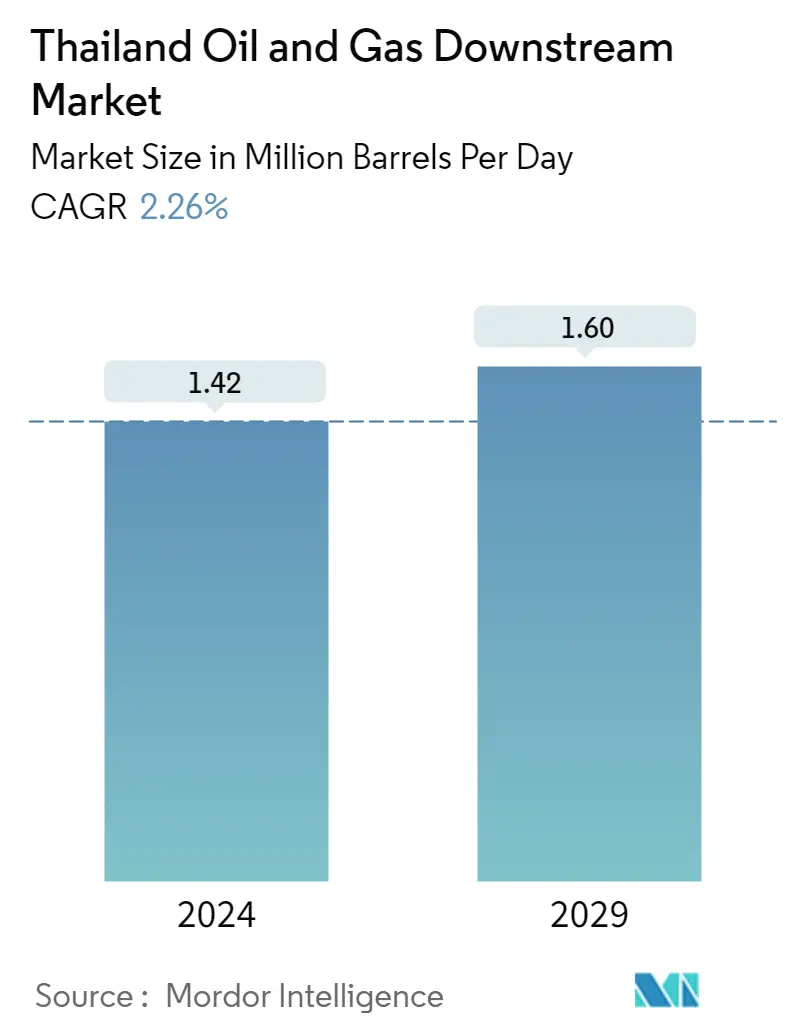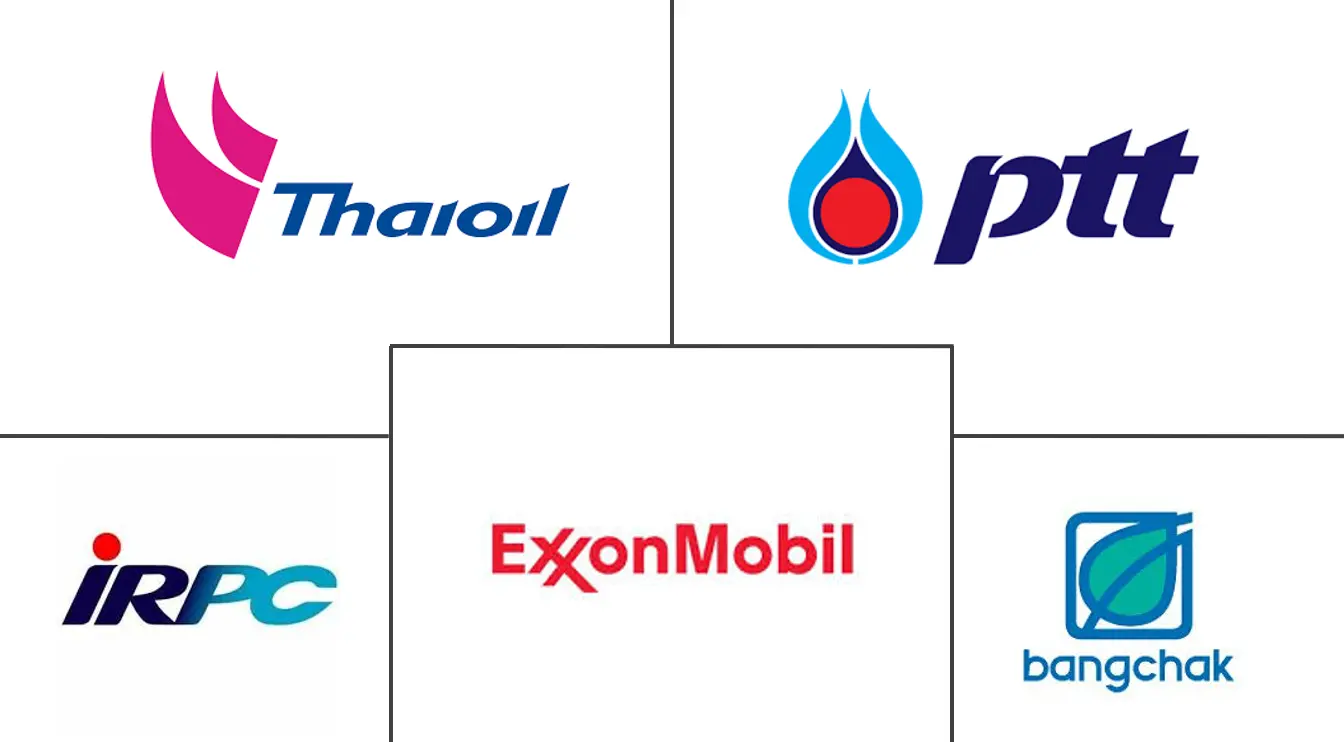Market Size of Thailand Oil and Gas Downstream Industry

| Study Period | 2021 - 2029 |
| Base Year For Estimation | 2023 |
| Forecast Data Period | 2024 - 2029 |
| Historical Data Period | 2021 - 2022 |
| CAGR (2024 - 2029) | 2.26 % |
| Market Concentration | Medium |
Major Players
*Disclaimer: Major Players sorted in no particular order |
Thailand Oil and Gas Downstream Market Analysis
The Thailand Oil and Gas Downstream Market size is estimated at 1.42 Million barrels per day in 2024, and is expected to reach 1.60 Million barrels per day by 2029, growing at a CAGR of 2.26% during the forecast period (2024-2029).
Although the market studied was negatively impacted by COVID-19 in 2020, it has recovered and reached pre-pandemic levels. With the growing demand for various refined products, the country is focused on developing its refinery capacity, which is expected to drive the growth of the market studied during the forecast period. However, the shifting trend toward cleaner alternatives, such as the increasing adoption of electric vehicles, is expected to hinder the demand for refined products from end-user industries, which is expected to restrain the market's growth.
Gas fields have been discovered in the Andaman Sea, increasing optimism about reducing the dependence on imported gas and the cost of natural gas transportation. This factor is creating an opportunity for the players in the sector.
Thailand Oil and Gas Downstream Industry Segmentation
Downstream operations are oil and gas processes that occur after the production phase to the point of sale. These processes are the final step in the path that oil and gas take from being in the ground to being in the hands of consumers.
The Thai oil and gas downstream market is segmented by refineries, petrochemical plants, and fuel retail and marketing. The market sizing and forecasts have been done based on refining capacity (thousand barrels per day).
| By Refineries | |
| Overview | |
| Existing, Under Construction, and Planned Projects |
| By Petrochemical Plants | |
| Overview | |
| Existing, Under Construction, and Planned Projects |
Thailand Oil and Gas Downstream Market Size Summary
The Thailand oil and gas downstream market is poised for growth, driven by the expansion of refinery capacity and the increasing demand for refined products. Despite the initial setbacks due to the COVID-19 pandemic, the market has rebounded to pre-pandemic levels. Thailand's refinery sector is the second largest in Southeast Asia, with significant investments aimed at enhancing capacity to meet both domestic and regional demands. The country's refineries, primarily owned by the national oil and gas conglomerate PTT, are undergoing expansions, such as the Clean Fuel Project at Thai Oil's Sriracha refinery, which is expected to boost production significantly. However, the market faces challenges from the shift towards cleaner energy alternatives, particularly the rising adoption of electric vehicles (EVs), which could dampen the demand for traditional refined products.
The discovery of gas fields in the Andaman Sea presents new opportunities for reducing reliance on imported gas, potentially lowering transportation costs for natural gas. Thailand continues to produce a substantial portion of its petroleum needs but still depends on imports to satisfy growing demand. The government's push towards 'Thailand 4.0' and the development of the EV industry, supported by favorable policies and incentives, is transforming the automotive sector. This shift is expected to impact the downstream oil and gas market, as the country aims to become a hub for zero-emission vehicles. The market is partially consolidated, with major players like Exxon Mobil Corporation, PTT Public Company Limited, and Thai Oil PCL playing significant roles. Strategic decisions, such as PTTEP's commitment to supply domestic refineries, are enhancing energy security and supporting the market's growth trajectory.
Thailand Oil and Gas Downstream Market Size - Table of Contents
-
1. MARKET OVERVIEW
-
1.1 Introduction
-
1.2 Installed Refining Capacity and Forecast, in thousand barrels per day, till 2027
-
1.3 Recent Trends and Developments
-
1.4 Government Policies and Regulations
-
1.5 Market Dynamics
-
1.5.1 Drivers
-
1.5.2 Restraints
-
-
1.6 Supply Chain Analysis
-
1.7 PESTLE Analysis
-
-
2. MARKET SEGMENTATION
-
2.1 By Refineries
-
2.1.1 Overview
-
2.1.2 Existing, Under Construction, and Planned Projects
-
-
2.2 By Petrochemical Plants
-
2.2.1 Overview
-
2.2.2 Existing, Under Construction, and Planned Projects
-
-
2.3 By Fuel Retail and Marketing
-
Thailand Oil and Gas Downstream Market Size FAQs
How big is the Thailand Oil and Gas Downstream Market?
The Thailand Oil and Gas Downstream Market size is expected to reach 1.42 million barrels per day in 2024 and grow at a CAGR of 2.26% to reach 1.60 million barrels per day by 2029.
What is the current Thailand Oil and Gas Downstream Market size?
In 2024, the Thailand Oil and Gas Downstream Market size is expected to reach 1.42 million barrels per day.

